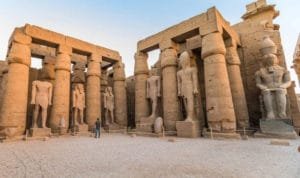What Do the Temples of Karnak and Philae Have in Store for You?
What Do the Temples of Karnak and Philae Have in Store for You?
Cultural and Spiritual Importance
- Temples as Centers of Worship and Power
- Influence on Modern Egyptian Identity
Cultural and Spiritual Importance
The cultural and spiritual significance of Egypt is deeply intertwined with its ancient temples, which have served as powerful centers of worship, governance, and community. These sacred structures, built by
Pharaohs and kings, symbolize the connection between the gods and the people. Temples like those found in Luxor, Karnak, Philae, and Abu Simbel are monumental not only in size but in their historical and
religious importance. These temples, dating back to ancient Egypt’s various periods, from the New Kingdom to the Ptolemaic era, stand as symbols of Egypt’s enduring legacy and deep spirituality.
Temples as Centers of Worship and Power
Temples such as Karnak, dedicated to the god Amun, and Luxor, serve as massive centers of religious activity and political power. The pylons at these sites reflect the architectural grandeur of the ancient Egyptians,
while the colossal columns and obelisks represent the strength and influence of the Pharaohs. Temples were often built by great rulers like Hatshepsut and Ramses II to honor gods like Amun, Ra, and Isis. The
temples in Thebes, Edfu, and Kom Ombo, along the Nile River, also stand as monumental testaments to the power that the kings wielded over both the religious and political realms. These ancient structures were
vital to maintaining order, with their massive complexes serving as hubs for both religious rites and the governance of the kingdom
Effect on Modern Egyptian Identity
The temples of ancient Egypt, such as those at Abu Simbel, Luxor, and Philae, continue to shape Egypt’s modern identity. Visitors today, whether exploring the massive buildings at Karnak or standing before the
towering obelisks, are reminded of Egypt’s rich history, which dates back to the time of the Pharaohs. The connection between the gods, particularly Amon, Horus, and Isis, and the Egyptians’ daily lives left an
indelible mark on the nation’s culture. Modern Egyptians still honor the legacy of their ancestors, whose religious and cultural practices were closely linked to the temples. Aswan, Thebes, and other cities remain
key centers for both tourism and cultural heritage, with their temples offering a glimpse into the ancient kingdom’s spiritual and political might. The massive temples built along the Nile by the kings of ancient
Introduction to Karnak and Philae Temples
- A Brief Overview of Egypt’s Ancient Religious Monuments
- Why Visit Karnak and Philae Temples Today?
A Brief Overview of Egypt’s Ancient Religious Monuments
Karnak and Philae temples are two of Egypt’s most renowned and iconic ancient religious sites. Located in Luxor and Aswan, respectively, they represent the grandest achievements of Egyptian temple architecture.
The Karnak temple complex, built over several centuries, is considered one of the largest and most impressive temple complexes in Egypt. Dating back to the Middle Kingdom and further expanded during the New
Kingdom, it was dedicated to the god Amun-Ra. Meanwhile, Philae, located on a picturesque island in the Nile, was primarily dedicated to the goddess Isis and became a major center of worship during the
Ptolemaic period. Both temples are monumental in scale, with massive pylons, grand columns, and diverse chapels that stand as testament to the ambition of the pharaohs. These temples, which still attract
thousands of travelers today, represent Egypt’s vast religious and architectural history. They continue to fascinate visitors, offering an opportunity to explore and discover Egypt’s ancient cults, rituals, and powerful
gods like Osiris and Horus.
Why Visit Karnak and Philae Temples Today?
Visiting Karnak and Philae temples is a must for any traveler interested in Egypt’s rich history and architecture. Karnak, located in the heart of Luxor, is the largest temple complex ever built in ancient Egypt,
dedicated to Amun, the principal god of Egypt. Visitors are greeted by a massive hall with towering columns, obelisks, and towering pylons, creating a truly magnificent sight. The Philae temple, located on an island
in the Nile, offers a unique experience. Here, visitors can take a boat to the island and discover the ancient temple dedicated to Isis, a goddess revered for centuries. Both temples, built over centuries, encompass
diverse religious rites and are crucial to understanding Egypt’s past. Exploring the vast grounds of Karnak or taking in the stunning view of the lake at Philae, travelers can engage in rituals once performed by the
ancient Egyptians. These temples are not only revered for their history but also for their incredible architectural designs, which remain some of the boldest and most ambitious projects of the ancient world.
Whether you’re captivated by their intricate carvings, monumental obelisks, or rich history, these temples offer an unparalleled opportunity to connect with the ancient Egyptian kingdom.
FAQ about Karnak and Philae Temples
Q1: Where are Karnak and Philae Temples located?
A: Karnak Temple is in Luxor, while Philae Temple is near Aswan, on Agilkia Island in the Nile.
Q2: Are Karnak and Philae Temples part of UNESCO World Heritage Sites?
A: Yes, both are part of UNESCO-listed zones due to their historical and cultural significance.
Q3: What gods were worshipped at Karnak and Philae?
A: Karnak was primarily dedicated to Amun-Ra. Philae was mainly dedicated to the goddess Isis.
Q4: How long does it take to explore each temple?
A: Karnak requires 2–3 hours, while Philae can be explored in 1.5–2 hours including the boat ride.
Q5: Can I visit both temples on the same day?
A: It’s challenging, as they’re in different cities (Luxor and Aswan), about 3.5 hours apart by train or 6 hours by car.


